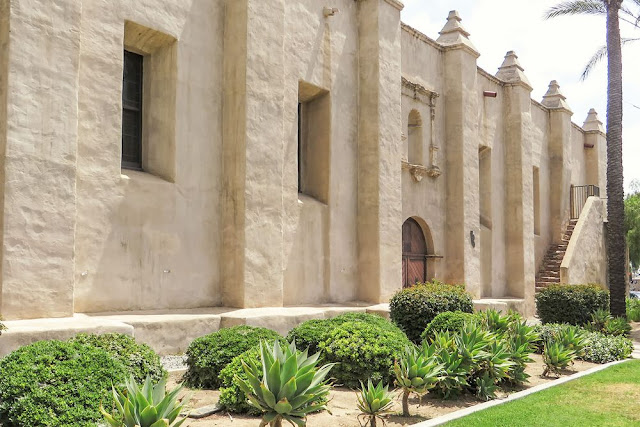San Gabriel Mission was the fourth one built in California. It was founded on September 8, 1771, by Fathers Pedro Cambon and Angel Somera. The name San Gabriel Mission is for the Arcangel Gabriel.
Interesting Facts about San Gabriel Mission
The mission is the only one in California with Moorish architecture. The design may have been based on the Cathedral of Cordova in Spain, which was once a Moorish mosque.
The mission also has no bell tower but a bell wall, or campanario, which has 6 ancient bells in it. (see photo below)
Another unique characteristics of the mission is its entrance. Most missions has their entrance doors on the narrower side of the building. At San Gabriel, it's on the longer wall which is what most people would think of as the side. (see photo below)
San Gabriel Mission is one of the best preserved in California, with many of its original features still intact, including six altar statues brought around the Horn of Africa in 1791 and a hammered copper baptismal font, a gift from King Carlos III of Spain in 1771.
The altar was made in Mexico City and brought to Mission San Gabriel in the 1790's. The statues were hand-carved in Spain.
Finally, settlers from the mission founded the City of Los Angeles.
1771 - 1800
In 1771, there were two Spanish missions in what is now California. They were at San Diego and Carmel, more than 400 miles apart.
Finally, settlers from the mission founded the City of Los Angeles.
1771 - 1800
In 1771, there were two Spanish missions in what is now California. They were at San Diego and Carmel, more than 400 miles apart.
More Franciscan missionaries arrived at Father Serra's headquarters that year, and he decided to build more missions between the two existing ones. In the summer of 1771, the Fathers created two more missions: Mission San Antonio de Padua which is south of Carmel and San Gabriel Mission in the area that is now Los Angeles.
Fathers Pedro Cambon and Angel Somera founded San Gabriel Mission on September 8, 1771. They named for the Arcangel Gabriel. It was the fourth in a chain of 21. The original plan was to place it on the Santa Ana River. When the founders arrived, they decided to go further inland to the San Gabriel River instead.
According to legend, native chiefs tried to stop the fathers from building their mission. The Fathers were afraid of a bloody battle but showed the Indians a painting the Virgin Mary as Our Lady of Sorrows and the Indians immediately threw down their bows and arrows.
For 7,000 years before the Spanish came, the Tongva Indians lived in the area of California where Los Angeles now is. They built permanent villages along streams and rivers. Their houses were made from willow branches and reeds. The Tongva called their houses "Kiiy" (pronounced "key").
For 7,000 years before the Spanish came, the Tongva Indians lived in the area of California where Los Angeles now is. They built permanent villages along streams and rivers. Their houses were made from willow branches and reeds. The Tongva called their houses "Kiiy" (pronounced "key").
The Spanish missionaries often renamed the local Indians after the name of the mission nearby. They called the Tongva Gabrielinos, and you may sometimes hear or see that name.
The Indians were friendly in the beginning and helped with the building. Baptisms began immediately after the founding. However, relationships with the Indians turned bad because of the soldiers. A soldier attacked a chief's wife and killed her husband when he tried to stop him. The fathers acted quickly and had the guilty soldier sent to another location.
In 1774, Spanish soldier and explorer Juan Bautista de Anza arrived at Mission San Gabriel from Mexico City. He established a land route that passed by San Gabriel Mission, making it near a busy crossroad. Its location made it one of the most important missions.
In 1775, the fathers found a better site closer to the mountains, and they moved the mission. In 1776, Fathers Sanchez and Cruzado took over the mission. They ran it for the next thirty years. They began church construction in 1779.
In 1781, two fathers, several Indians, and eleven families left the mission and traveled nine miles west to form a civilian settlement. They called it El Pueblo de Nuestra la Reina de Los Angeles (The City of Our Lady Queen of the Angels). It is the present city of Los Angeles.
1800-1830s
In 1805, Fathers Sanchez and Cruzado both died, shortly before the building was completed. Father Jose Zalvidea came to replace them and stayed for the next 20 years.
Secularization
After Mexico won independence from Spain, the missions were secularized. Their land was supposed to be transferred to the natives. Instead, most of it fell into the hands of dishonest politicians and their friends. The mission was turned over to a civil administrator in 1834.
 |
| 1870 |
1800-1830s
In 1805, Fathers Sanchez and Cruzado both died, shortly before the building was completed. Father Jose Zalvidea came to replace them and stayed for the next 20 years.
Secularization
After Mexico won independence from Spain, the missions were secularized. Their land was supposed to be transferred to the natives. Instead, most of it fell into the hands of dishonest politicians and their friends. The mission was turned over to a civil administrator in 1834.





No comments:
Post a Comment